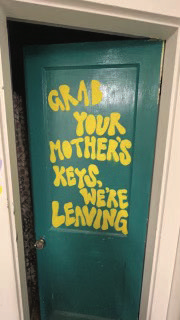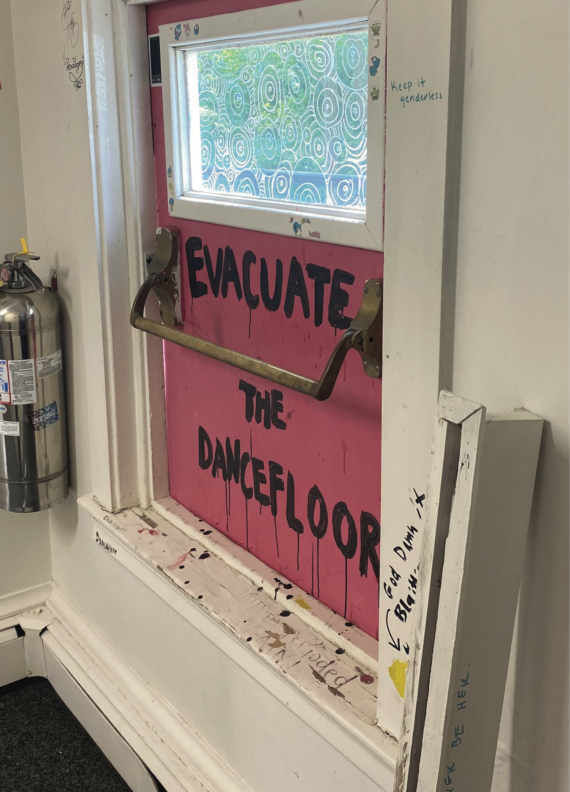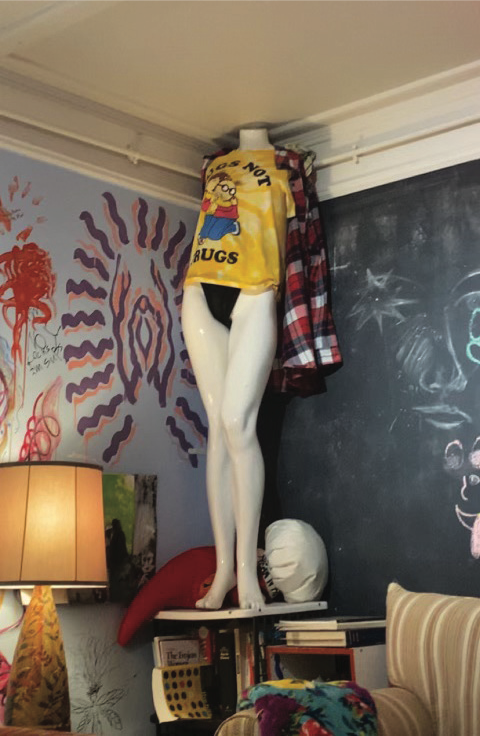By Elsie Carson and Lily Maguire
“Get naked or get out!” Those five words were bright and bold on the Art Haus wall in their living room for years. First painted on in 2019, the words became the motto for Art Haus. One didn’t actually have to get naked or get out, but these words instead spoke of the safe space for artistic expression that Art Haus represents.
Art Haus, located at 44 Howard Street, houses six residents, and hosts events to foster art on Wheaton’s campus. It describes itself as “a place where artists of all media can express themselves and interact with other artists. The goal is to maintain a community centered around art appreciation that is dedicated to helping the arts flourish at Wheaton.”
Following this mural came many more of a similar brand, until Art Haus was covered in provocative, innocent, and all around fun and festive colors and paint. Generations of Haus members’ art branded the walls, doors and windows.

A mannequin, affectionately called Hilga, was the unofficial mascot of the Haus.“Grab Your Mother’s Keys, We’re Leaving,” painted bright yellow on a door was a relic from the early 2010s indie rock, as was “evacuate the dance floor” written on the fire escape.
These are some of the pieces that make Art Haus so special. Benjamin Campbell describes Art Haus as “a safe haven for artistic expression of any kind, one of the last safe havens for artistic expression on campus, both within majors and outside the major.”
But this “safe haven” for artists was disrupted over the summer, when Art Haus was fully repainted to a sterile white, covering over the murals that gave the house its character. The Residential Life Team, Dean of Students Leadership, and Physical Plant team did a walk through Art Haus in the mid-summer, and determined that “the house needed to be renovated, as the floors, furniture, and walls were covered in mismatched paint, graffiti, and messages that did not meet the standards of the Wheaton Community,” said head of residential life Tim Jordan in an email to The Wire.
Jordan said that over the summer, the floors and interior have been painted, the bathroom underwent renovation, and that new furniture was ordered. He also met with Art Haus leadership, and their faculty advisor, Kelly Goff, to create new guidelines for the house, including allowing painting in the common space but not bedrooms.
As we’re talking, the President of Art Haus, Benjamin Campbell, lists the lost pieces in the haus that were considered heirlooms, “Evacuate the dance floor was an heirloom. There was a large face out in the hallway. That was gorgeous… there was one there, there was a piece right there” he falters, as he tries to remember other pieces, “they’re slipping away already.” Said Campbell.
Art Haus members agree that renovation was needed for structural continuity, but also claim that no issues were really solved by the summer renovations.
“They didn’t really actually fix anything. They hired an outside contractor and they just took a spray and sprayed over everything” co-president Harrison Rios said. As a result, some of the doors do not close fully anymore due to the amount of paint, and cannot be altered, either stripped down or added to, which according to treasurer Avery Cox, disrupts a longstanding house tradition.

“An arthouse tradition that has been going way back is that everyone paints their doors to their room to make it their individual space and their own. And they painted all the doors white, which, for one, makes it that you can’t open or close them all the way.” Cox told The Wire.
House members also say that the renovation team bagged everything in the living room and basement, causing pottery, sculptures, and other pieces of artwork to be destroyed, something house members want to seek compensation for.
The most glaring problem for Art Haus is the complete lack of communication from Residential Life. “My issue is not that the house is painted over, it was the fact of how it was handled.” Said Campbell. “I just really wish it was a conversation much earlier on. I wish it was not. ‘Alright, let’s just cover everything white’. I wish it was, okay, ‘what? What can we redo? And what can we change?”
Heirlooms Lost
For Art Haus’ existence, members had access to the haus as their canvas, and had freedom to paint however they wanted. According to members of the haus, one couldn’t look in any corner without seeing an heirloom piece, some even painted by professors when they themselves were students at Wheaton. It was a concrete reminder of the generations of artists who had lived in the house.
“What really upsets me, is that with a lot of the older pieces, there was absolutely no communication and a complete rejection of any possibility of conservation” Shared Campbell.
“If we had removed every single one of these walls and placed them in Beard Gallery, it would have been an exhibit,” Campbell went on, as the other house members nodded in agreement. “Where’s the line that you draw between what’s real art?”
When The Wire asked how Wheaton Administration making calls like painting over Art Haus impacts the house, Cox jumped in immediately.
“It impacts free expression,” they said. “[free expression] includes nudity and stuff too.” Said Cox
Changes at Wheaton
Art Haus’ walls being painted over means the loss of a decade of art from Art Haus alumni. But it also touches on something deeper many Wheaton students feel.
This year’s graduating class never experienced the traditions that most other Wheaton students are exposed to. People at Art Haus mentioned they have the sense that something shifted after the pandemic, something I have heard echoed throughout other conversations on campus and throughout my time here.
When the majority of students spent at least some of their formative years of college locked in their dorm rooms, discouraged from socializing with each other to keep themselves and their community safe, it doesn’t seem like a jump to assume that a sense of tradition and community was lost.
“Post COVID I think things are kind of losing a bit of color, so to speak.” co-president Harrison Rios said during our interview.
Wheaton is unique in our lack of off-campus housing. Almost the entire student body lives on campus all four years, shuffling from dorm to dorm and never really settling down. Most people, by the time they are no longer first-years, want somewhere more permanent to call their home, somewhere that makes them feel like a part of a community, where they can decorate the walls and express themselves freely.
Campbell says that moving into Art Haus made them feel like they were a part of a community, something that matters because “post-COVID those communities are really, really dwindling.”
“I feel like there are a lot more people on campus who feel like they could call this house their own…it is a space for the entire artistic community. And with the restrictions that I see happening, I’m worried that those safe spaces are going to be harder and harder to come by”.
Art Haus members also spoke to how the arts programs at Wheaton are being defunded, and with the introduction of the new nursing program, it seems like the school is shifting its focus more and more to the sciences.
“If we want to be a liberal arts institution, we should be supporting the arts in the liberal arts,” said Campbell.
Last summer, the Residential Life team came under fire for the confiscation of furniture and decorations from theme houses. While progress has been made, it seems like there is an inherent struggle in that residents of theme houses like Art Haus want to make permanent changes, pass down traditions, and make a place feel like home, that ultimately is owned by, and therefore controlled by, Wheaton and its guidelines.
Art Haus has already started repainting the walls in the common room, but are upset at the fact that they cannot paint their doors anymore, or other rooms in the house. They have also replaced the mannequin (Hilga) which was lost in the renovation, with a new one, named Enrique.
Art Haus wants to have an improved relationship with the Res Life team and Wheaton administration. As Campbell says, “I don’t want to fight with Res Life, they talk so much about promoting collaborative work. I am all for that. I will put all my effort towards making sure that we can collaborate and find common ground. We just need to be respected and have a voice.”
